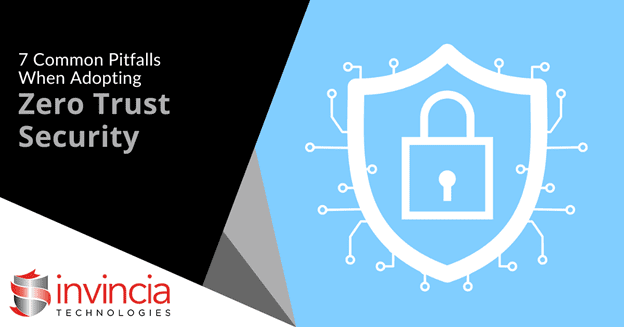Introduction:
Zero Trust Security has emerged as a critical framework in modern cybersecurity, offering a proactive approach to protect against evolving threats. However, its implementation can be complex, leading to several common pitfalls that organizations must navigate. With the expertise and solutions provided by Invincia Technologies, businesses can overcome these challenges and successfully adopt a robust Zero Trust Security strategy.
- Underestimating Complexity:
Zero Trust Security involves a paradigm shift from traditional perimeter-based security models. Underestimating the complexity of this transition can lead to implementation challenges and gaps in security coverage. Invincia Technologies offers comprehensive assessments and tailored solutions to help organizations understand and navigate the intricacies of Zero Trust architecture.
- Inadequate Access Controls:
Effective Zero Trust Security relies on granular access controls to verify and authenticate every user and device accessing the network. Inadequate access controls can result in unauthorized access and data breaches. Invincia Technologies provides robust identity and access management solutions, ensuring only authorized entities gain entry to sensitive resources.
- Neglecting Endpoint Security:
Endpoints represent critical entry points for cyber threats in a Zero Trust environment. Neglecting endpoint security measures can leave organizations vulnerable to malware and unauthorized access. Invincia Technologies offers advanced endpoint protection solutions, including endpoint detection and response (EDR) capabilities, to defend against sophisticated threats.
- Siloed Security Tools:
Deploying disparate security tools without proper integration can create silos of information, hindering visibility and response capabilities. Invincia Technologies offers a unified security platform that integrates seamlessly with existing tools, providing holistic visibility and centralized management of security operations.
- Lack of User Awareness:
Zero Trust Security requires a shift in mindset, emphasizing continuous verification and cautious behavior from users. Without proper education and awareness programs, employees may inadvertently bypass security controls or fall victim to social engineering attacks. Invincia Technologies offers comprehensive training and awareness programs to empower users and reinforce security best practices.
- Overlooking Data Protection:
While Zero Trust Security focuses on securing access to resources, it’s essential not to overlook the protection of sensitive data itself. Inadequate data encryption, classification, and monitoring can expose organizations to data breaches and compliance violations. Invincia Technologies provides robust data protection solutions, including encryption, data loss prevention (DLP), and data classification tools, to safeguard critical information.
- Failing to Adapt:
Cyber threats are continually evolving, requiring organizations to adapt their security strategies accordingly. Failing to evolve and update Zero Trust Security measures can leave businesses vulnerable to emerging threats. Invincia Technologies offers proactive threat intelligence and continuous monitoring services, ensuring organizations stay ahead of evolving threats and maintain a resilient security posture.
Conclusion:
As organizations embrace Zero Trust Security to protect against modern cyber threats, it’s essential to be aware of common pitfalls and challenges along the journey. With the expertise and support of Invincia Technologies, businesses can navigate these challenges effectively and implement a robust Zero Trust Security strategy tailored to their unique needs.

